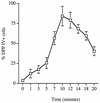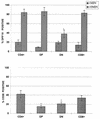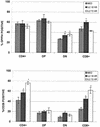Multicolor cytoenzymatic evaluation of dipeptidyl peptidase IV (CD26) function in normal and neoplastic human T-lymphocyte populations
- PMID: 9605992
- PMCID: PMC104525
- DOI: 10.1128/CDLI.5.3.362-368.1998
Multicolor cytoenzymatic evaluation of dipeptidyl peptidase IV (CD26) function in normal and neoplastic human T-lymphocyte populations
Abstract
Dipeptidyl peptidase IV (DPP IV), also identified as the glycoprotein CD26, is a transmembrane 110- to 120-kDa serine aminopeptidase involved in immune responses by influencing T-cell costimulation and by cleaving cytokines. Additionally, CD26 is a nonintegrin receptor that contains a binding site for extracellular matrix and other molecules. In order to further define the expression and functional activity of this membrane exopeptidase in human T cells, we developed a nondisruptive, four-color cytofluorogenic assay that utilizes three separate antibodies to cell-surface molecules (e.g., CD4/CD8/CD26 and CD19/CD56/CD26) along with a rhodamine 110-conjugated dipeptide substrate that allows the measurement of DPP IV activity in phenotypically defined cells. We found normal human thymi to have notable differences in time-dependent DPP IV activity among the thymocyte subsets defined by their CD4/CD8 phenotype, with CD4-/CD8- thymocytes containing less DPP IV activity than cells expressing CD4 and/or CD8 (i.e., maturing). CD26 positivity was moderately intense in thymocytes and tended to identify cells with higher DPP IV activity. The four-color technique was also used to examine mature peripheral blood lymphocytes, along with an assortment of leukemias and transformed T-cell lines. These experiments revealed that while DPP IV was consistently evident in normal T cells, neoplastic T cells could vary in their expression patterns. Furthermore, the presence (or intensity) of surface CD26 in some abnormal T cells and certain normal peripheral blood mononuclear cells was separable from the level of DPP IV measured intracellularly. Our results established that multicolor cytofluorographic analysis can be a practical means to measure DPP IV activity in various human cell populations. Furthermore, we found that DPP IV activity could vary in T cells according to their differentiation status and that under certain circumstances surface CD26 expression can be disassociated from the level of measured enzyme (i.e., DPP IV) activity.
Figures






Similar articles
-
Human thymocyte dipeptidyl peptidase IV (CD26) activity is altered with stage of ontogeny.Clin Immunol Immunopathol. 1998 Aug;88(2):156-68. doi: 10.1006/clin.1998.4550. Clin Immunol Immunopathol. 1998. PMID: 9714693
-
Dipeptidyl peptidase IV (CD26) activity in human alloreactive T cell subsets varies with the stage of differentiation and activation status.Transpl Immunol. 1997 Jun;5(2):152-61. doi: 10.1016/s0966-3274(97)80056-1. Transpl Immunol. 1997. PMID: 9269038
-
Cytofluorographic evidence that thymocyte dipeptidyl peptidase IV (CD26) activity is altered with stage of ontogeny and apoptotic status.Cytometry. 1996 Apr 1;23(4):322-9. doi: 10.1002/(SICI)1097-0320(19960401)23:4<322::AID-CYTO8>3.0.CO;2-I. Cytometry. 1996. PMID: 8900475
-
Further characterization of DPP IV-beta, a novel cell surface expressed protein with dipeptidyl peptidase activity.Adv Exp Med Biol. 1997;421:193-9. doi: 10.1007/978-1-4757-9613-1_25. Adv Exp Med Biol. 1997. PMID: 9330697 Review.
-
The structure and function of CD26 in the T-cell immune response.Immunol Rev. 1998 Feb;161:55-70. doi: 10.1111/j.1600-065x.1998.tb01571.x. Immunol Rev. 1998. PMID: 9553764 Review.
Cited by
-
Minimal residual disease detection by flow cytometry in adult T-cell leukemia/lymphoma.Am J Clin Pathol. 2010 Apr;133(4):592-601. doi: 10.1309/AJCPS1K0OHLJYWWV. Am J Clin Pathol. 2010. PMID: 20231613 Free PMC article.
-
CD26/DPP-4 in Chronic Myeloid Leukemia.Cancers (Basel). 2022 Feb 11;14(4):891. doi: 10.3390/cancers14040891. Cancers (Basel). 2022. PMID: 35205639 Free PMC article. Review.
References
-
- Abbott C A, Baker E, Sutherland G R, McCaughan G W. Genomic organization, exact localization, and tissue expression of the human CD26 (dipeptidyl peptidase IV) gene. Immunogenetics. 1994;40:331–338. - PubMed
-
- Alhanaty E, Shaltiel S. Limited proteolysis of the catalytic subunit of cAMP-dependent protein kinase: a membranal regulatory device 656. Biochem Biophys Res Commun. 1979;89:323–332. - PubMed
-
- Assfalg-Machleidt I, Rothe G, Klingel S, Banati R, Mangel W F, Valt G, Machleidt W. Membrane permeable fluorogenic rhodamine substrates for selective determination of cathepsin L. Biol Chem Hoppe-Seyler. 1992;373:433–440. - PubMed
-
- Bauvois B. Murine thymocytes possess specific cell surface-associated exoaminopeptidase activities: preferential expression by immature CD4-CD8-subpopulation. Eur J Immunol. 1990;20:459–468. - PubMed
-
- Bednarczyk J, Carroll S M, Marin C, McIntyre B. Triggering of the proteinase dipeptidyl peptidase IV (CD26) amplifies human T lymphocyte proliferation. J Cell Biochem. 1991;46:206–218. - PubMed
MeSH terms
Substances
LinkOut - more resources
Full Text Sources
Medical
Research Materials
Miscellaneous

